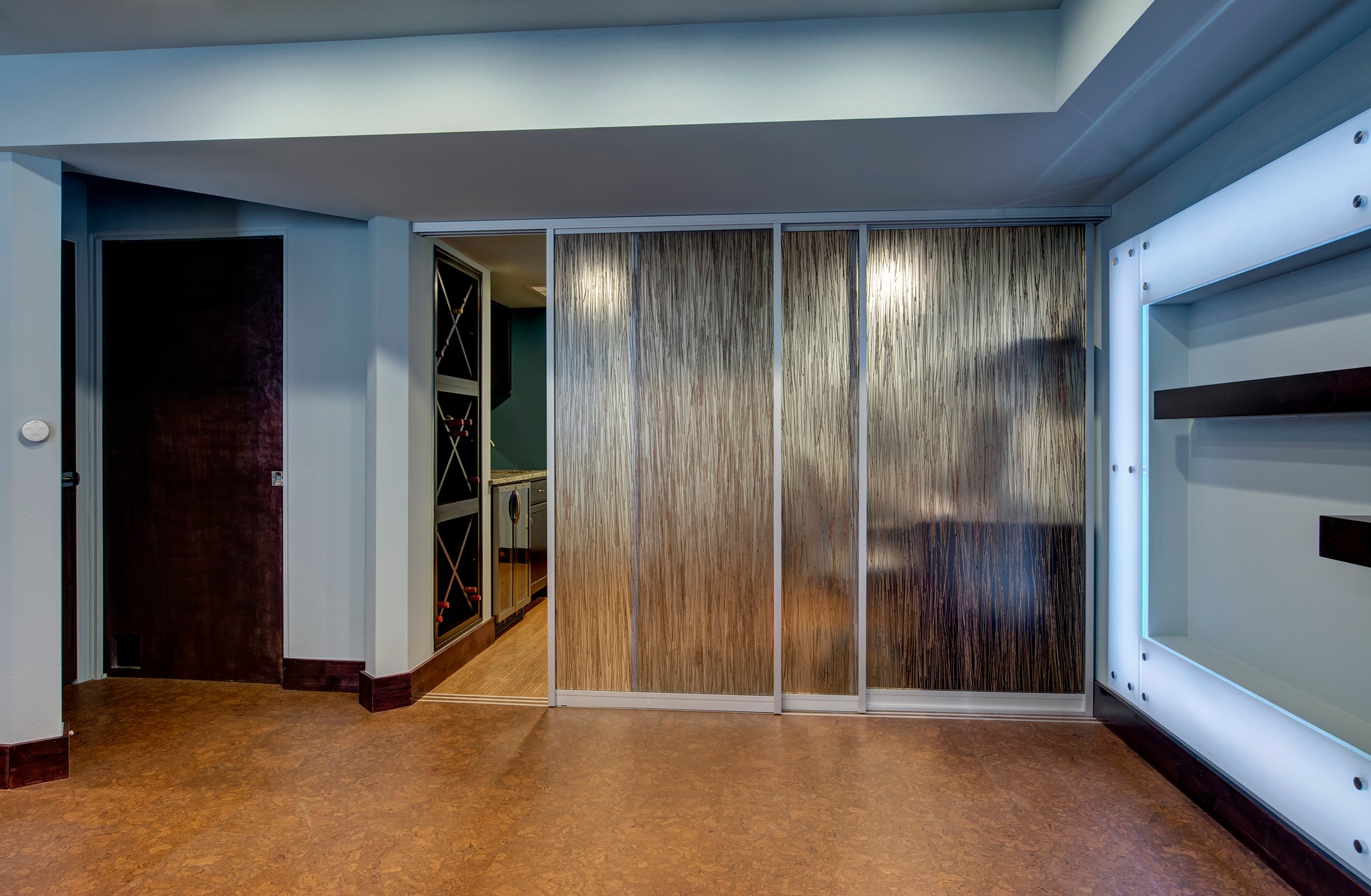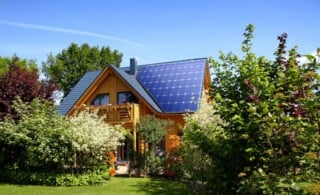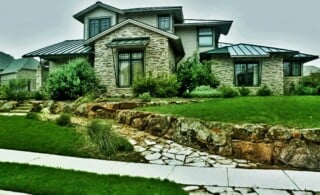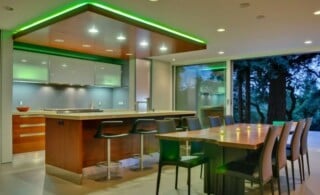
A basement remodel is one of the easiest and most cost-effective ways to add valuable square footage to your home. But basements can also present some significant remodeling challenges, such as working with limited and awkward spaces, alleviating moisture problems, and meeting design challenges such as where to run plumbing, ductwork, and other utilities. Add to that the higher standards of green remodeling in the areas of energy efficiency, healthy indoor environments, and the type of materials you use, and it becomes clear that you need to know what you’re doing if you hope to get a green basement remodel off on the right foot.
The Costs of Going Green
Truth be told, pinning down an accurate dollar amount for going green in the basement is easier said than done. The level of green that each homeowner is willing to commit to varies, as does the level of work required by each individual product. That goes double for basements, especially if you have moisture problems to address before the actual remodeling begins. That being said, there are several factors related to cost that you can count on:
- Going green doesn’t necessarily mean higher costs. Many green building practices and materials are cheaper than traditional ones. Furthermore, since green places a premium on efficiency, these projects tend to get completed quicker, which reduces labor costs.
- Green remodels are virtually guaranteed to reduce your energy and utility costs over time, which can help to off-set higher initial costs over time.
- Assigning value to green basement remodel means looking beyond the bottom line.
Use our guide to calculate basement conversion costs for your remodeling project.
“Avoiding the Payback Trap”
This last point is an important one. Whether you’re aware of it or not, going green means a lot more than just saving on future energy costs. First of all, it stresses creating healthier home environments, which is a major concern in basements where high moisture levels and sub-par ventilation can create some serious indoor air quality issues. It also means using low-maintenance, high-quality materials, so you’ll lose less time in the future to maintenance chores and repair work. And last, but certainly not least, it means doing right by the environment so you can rest easy knowing that you’ve done everything you can to pass a better, more sustainable world onto your children and grandchildren. When you take those factors into consideration, it’s easy to see how the value of a green remodel extends beyond dollars and cents.
Ready to start your Basement Remodel?
Find ProsGoing Green = Healthier Basements
Though increasing energy efficiency is always a primary concern with any green remodeling project, the biggest benefit of going green in the basement just might be creating a healthier indoor environment. Why? The high moisture content of basements makes them a prime breeding ground for harmful mold; a basement’s orientation below grade often leads to high radon levels (a proven cause lung cancer); and many traditional building materials off-gas harmful chemicals like formaldehyde, vinyl chloride fumes, and other volatile organic compounds (VOCs). Combine all those factors with the poor ventilation commonly found in basement areas, and you’ve got all the ingredients for a potentially hazardous indoor environment.
Green remodeling is your answer to all of these issues. It addresses moisture issues from the get-go, places an emphasis on proper ventilation, and stresses the use of building products that minimize the presence of indoor air contaminants as much as possible. The result is a safer basement remodel for you, your children, and anyone else that lives under your roof. Here are some green suggestions for creating healthier basements for you and yours.
- Extend gutter drains and install drainage systems. Doing so directs water away from your foundation, reducing moisture issues and the health concerns associated with them.
- Install other moisture mitigation strategies. Properly sloped grades, drainage systems installed at the base of foundations, and moisture barriers installed along foundation walls all help to prevent moisture problems, as well.
- Utilize radon mitigation strategies. Radon, estimated by the EPA to be the second leading cause of lung cancer in Americans behind smoking, is a naturally occurring, radioactive gas that can leach into basements from the surrounding soil. Properly sealed basements, sub-slab ventilation, self-priming drains or gas traps, and radon mitigation systems can be used independently, or in concert, to reduce radon levels in your basement.
- Avoid wallpaper and carpet. Both of these products emit volatile organic compounds (VOCs) that have been linked to everything from high asthma rates to cancer. They also trap moisture and harbor mold growth, which has been shown to contribute to a host of health problems, including some serious immune and nervous system disorders.
- Avoid vinyl flooring. Vinyl flooring emits vinyl chloride fumes, a known carcinogen, and can trap moisture that leads to mold growth.
- Use exposed concrete as the finished floor. Doing so virtually eliminates moisture issues, mold development, and VOC concerns commonly associated with other basement flooring applications.
- Use formaldehyde-free materials. Many traditional building materials, including medium density fiberboard, particle board, and fiberglass batt insulation, contain formaldehyde that can off-gas into your indoor environment.
- Use low-VOC paints, adhesives, and sealants. Many traditional finishing products (paints, stains, and sealants) that are used on walls, flooring, and other applications, emit volatile organic compounds (VOCs) for long periods after being applied. Low- or no-VOC products keep these common indoor air contaminants to a minimum or eliminate them altogether.
- Install filters on basement water faucets, or a home water treatment system. Investigate local water quality first, however, since different filters meet different needs.
Tips on Increasing Energy Efficiency
Increasing energy efficiency is probably the most common reason homeowners are drawn to green remodeling in the first place. The truth is that basements are naturally green, since their orientation below grade provides insulation that the rest of your home doesn’t enjoy. However, that doesn’t mean that a green basement can’t increase your home’s energy efficiency and lower utility costs. Here are some tried and true strategies that will help to reduce energy consumption once your basement remodel is complete.
- Insulate plumbing, and relocate it from outside walls. Doing so helps to reduce heat loss as water travels from your hot water heater to the faucet, which in turn reduces water heating costs.
- Install low-flush toilets and low-flow faucets. You can cut water use at these fixtures by 60 percent or more by installing energy-efficient models.
- Use compact fluorescent light bulbs. They use 75 percent less energy than incandescent bulbs, and last 10 times as long.
- Install sealed or airtight recessed light fixtures. These fixtures will help eliminate unnecessary air leaks, thereby increasing overall energy efficiency.
- Insulate walls, ceilings, and foundations. Generally speaking, the more insulation you install, the better. Be sure to protect insulation from potential sources of moisture, however, as it can be a breeding ground for mold.
- Caulk, seal, and weatherstrip especially around metal basement windows. Doing so further increases energy efficiency and reduces energy costs.
- Replace metal windows with low-e, multiple paned windows with vinyl or wood frames. Not only do these windows eliminate a common source of heat and cooling loss in basements, but they provide valuable natural light, as well.
- Install solar tubes or fiber optic lighting solutions. These green lighting solutions can direct natural light all the way down into the basement, and reduce energy costs associated with artificial lighting.
- Consider upgrading your heating and cooling system. Since the HVAC systems in most homes are located in the basement, this is a good time to replace older units with new, high-efficiency models.
Ready to start your Basement Remodel?
Find ProsComfort, Quality, Durability, and Green Basement Remodeling
Going green doesn’t mean settling for lower quality, or sacrificing looks and comfort for environmentally friendly products. In fact, the opposite is usually the case. Green remodeling requires contractors to pay closer attention to their building practices; green products utilize the most cutting edge technology and design features; and green building focuses on materials that are long lasting and durable, since the best materials from a green standpoint are often the best building materials, period. Here are some green basement remodeling strategies that will result in a more comfortable, higher quality, and longer lasting basement, every time.
- Install adequate insulation. Installing adequate insulation means more comfortable indoor environments, and helps reduce noise pollution.
- Make the most of natural lighting. One of the biggest complaints about basements is that they are dark and uninviting. Doing everything you can to bring natural light into the basement will make a more enjoyable place to spend your time. You can do this by extending window wells, especially on the south side, to let in more light.
- Plan for the future, as well as the present. Design your basement remodel with the future in mind. Transforming vacant kids rooms into home offices or workout areas, for example, is much easier if you’ve planned for it ahead of time and remodeled accordingly.
- Use quality green flooring and countertop materials. FSC-certified engineered wood, bamboo, cork, and stone and ceramic tile are all recognized as some of the most attractive, trendsetting flooring materials on the market. And when it comes to countertops, solid slab stone, engineered stone, and concrete, aren’t just healthier alternatives, they are your most durable and attractive options, as well.
Environmental Responsibility in the Basement
Any discussion of green remodeling would be incomplete without talking about environmental responsibility. After all, at its heart green remodeling is about living more harmoniously with our environment and passing a better world on to younger generations. That being said, here is advice on simple steps you can take to embrace a more environmentally responsible, and sustainable, basement remodel.
- Use recycled building materials. If you’re willing to be flexible when it comes to design, perfectly good sinks, cabinet hardware, and ceramic and stone tile, for example, can all be purchased from retailers who specialize in reclaiming and recycling old building materials.
- Use materials manufactured with recycled content. Whether you install cellulose insulation made from recycled paper and cardboard, recycled content ceramic or carpet tiles, or concrete with recycled content additives, choosing building materials that incorporate recycled content helps to reduce the amount of waste that ends up in landfills, and reduces overall energy consumption since these products require less energy to make.
- Use Forest Service Council (FSC) certified wood. From flooring to framing materials, using only FSC-certified wood ensures that the lumber used in your major renovation has been harvested in a responsible and sustainable manner. Using reclaimed or engineered lumber eliminates the need to harvest live trees altogether.
- Recycle construction and jobsite waste. A large percentage of the construction waste currently sent to landfills can be reused in future green remodeling projects.
- Increasing efficiency isn’t just good for your pocketbook. Whether it’s reducing the amount of fossil fuels needed to heat and light your basement, or eliminating wasteful use of a valuable natural resource like water, any steps you take to cut your home utility costs are beneficial for the environment, as well.
Is Green the Right Color for Your Basement Remodel?
Going green with your basement remodel is a smart move from just about every angle. It reduces energy costs, creates healthier indoor environments, and the final product is a more comfortable, higher quality basement area. And, of course, it’s a good choice for the environment, as well.
Even better, going green doesn’t have to be a huge commitment. It’s true that the greenest basement remodel is one that incorporates green building practices into every facet of your remodel from the ground up. But simple things like ensuring proper ventilation, maximizing natural lighting, and choosing environmentally friendly flooring, countertop, and cabinet materials are all smart steps in a green direction.
If you think your basement remodel would look better in green, talk to your present contractor about adopting a green building philosophy, find a contractor who specializes in green building and remodeling, or seek out the services of a green consulting firm to help you make the right decisions in designing the perfect green basement for your home.
 Think Home Safety with Your Basement Remodel
Think Home Safety with Your Basement Remodel  Sustainable Home Improvements that Help Save the Planet
Sustainable Home Improvements that Help Save the Planet  Green Building Glossary
Green Building Glossary  Green Kitchens
Green Kitchens  “Green” Interior & Exterior Windows
“Green” Interior & Exterior Windows 

Are You Familiar With This Topic? Share Your Experience.